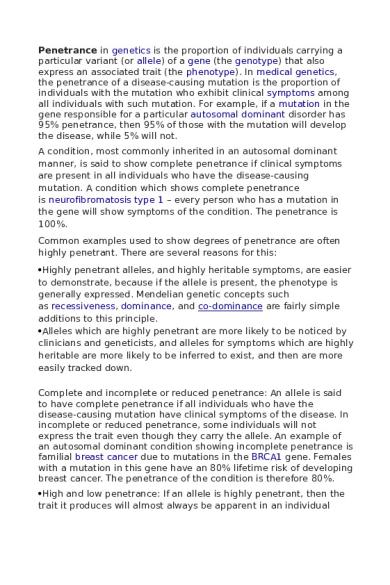Penetrance - notes PDF

| Title | Penetrance - notes |
|---|---|
| Course | Human Resource Management |
| Institution | Colegio de San Juan de Letran |
| Pages | 2 |
| File Size | 42.9 KB |
| File Type | |
| Total Downloads | 110 |
| Total Views | 129 |
Summary
notes...
Description
Penetrance in genetics is the proportion of individuals carrying a particular variant (or allele) of a gene (the genotype) that also express an associated trait (the phenotype). In medical genetics, the penetrance of a disease-causing mutation is the proportion of individuals with the mutation who exhibit clinical symptoms among all individuals with such mutation. For example, if a mutation in the gene responsible for a particular autosomal dominant disorder has 95% penetrance, then 95% of those with the mutation will develop the disease, while 5% will not. A condition, most commonly inherited in an autosomal dominant manner, is said to show complete penetrance if clinical symptoms are present in all individuals who have the disease-causing mutation. A condition which shows complete penetrance is neurofibromatosis type 1 – every person who has a mutation in the gene will show symptoms of the condition. The penetrance is 100%. Common examples used to show degrees of penetrance are often highly penetrant. There are several reasons for this: Highly penetrant alleles, and highly heritable symptoms, are easier to demonstrate, because if the allele is present, the phenotype is generally expressed. Mendelian genetic concepts such as recessiveness, dominance, and co-dominance are fairly simple additions to this principle. Alleles which are highly penetrant are more likely to be noticed by clinicians and geneticists, and alleles for symptoms which are highly heritable are more likely to be inferred to exist, and then are more easily tracked down. Complete and incomplete or reduced penetrance: An allele is said to have complete penetrance if all individuals who have the disease-causing mutation have clinical symptoms of the disease. In incomplete or reduced penetrance, some individuals will not express the trait even though they carry the allele. An example of an autosomal dominant condition showing incomplete penetrance is familial breast cancer due to mutations in the BRCA1 gene. Females with a mutation in this gene have an 80% lifetime risk of developing breast cancer. The penetrance of the condition is therefore 80%. High and low penetrance: If an allele is highly penetrant, then the trait it produces will almost always be apparent in an individual
carrying the allele. An allele with low penetrance will only occasionally produce the trait with which it is associated. In cases of low penetrance, it can be difficult to distinguish environmental from genetic factors....
Similar Free PDFs
Popular Institutions
- Tinajero National High School - Annex
- Politeknik Caltex Riau
- Yokohama City University
- SGT University
- University of Al-Qadisiyah
- Divine Word College of Vigan
- Techniek College Rotterdam
- Universidade de Santiago
- Universiti Teknologi MARA Cawangan Johor Kampus Pasir Gudang
- Poltekkes Kemenkes Yogyakarta
- Baguio City National High School
- Colegio san marcos
- preparatoria uno
- Centro de Bachillerato Tecnológico Industrial y de Servicios No. 107
- Dalian Maritime University
- Quang Trung Secondary School
- Colegio Tecnológico en Informática
- Corporación Regional de Educación Superior
- Grupo CEDVA
- Dar Al Uloom University
- Centro de Estudios Preuniversitarios de la Universidad Nacional de Ingeniería
- 上智大学
- Aakash International School, Nuna Majara
- San Felipe Neri Catholic School
- Kang Chiao International School - New Taipei City
- Misamis Occidental National High School
- Institución Educativa Escuela Normal Juan Ladrilleros
- Kolehiyo ng Pantukan
- Batanes State College
- Instituto Continental
- Sekolah Menengah Kejuruan Kesehatan Kaltara (Tarakan)
- Colegio de La Inmaculada Concepcion - Cebu















